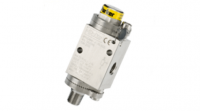

When managing the pressure within your system, there is a vast range of specific valves that can help to control and reduce this pressure. With so many different methods of controlling system pressure, it can be useful to know about these in detail so you can choose the most applicable type of valve for your system. If you would like to know about the various types of pressure relief valves in further detail, continue reading this comprehensive guide from Fluid Controls.
A pressure relief valve is an incredibly useful and necessary mechanism found in a variety of applications. The purpose of these valves is to protect the integrity of a system if the pressure reaches an alarming level. These typically work by opening up to allow the pressure to release outside of the system.
A pressure relief valve then closes over once the correct pressure level is reached to continue the regular function. These are essential to your system as overpressure could have dangerous consequences if not managed effectively.
The types of pressure relief valves can be classified into the following three categories, all with specific intended applications:
A Relief Valve is a pressure relief device that is spring-loaded and features gradual opening and closing. They are actuated by the upstream pressure and are best used with incompressible fluids. There are two types of relief valves: adjustable and electronic. Adjustable relief valves allow pressure setting changes via the outlet port. Electronic relief valves are capable of zero leakage using electric controls that observe and regulate system pressure. These types of relief valves are commonly used in close discharge systems.
Safety valves are for use with compressible fluids, such as vapours and gas. These are recognised by their quick opening and closing action. Safety valves are commonly used in steam plants for boiler overpressure protection.
They are classified into three distinct categories based on the amount of lift during the pop-up function. Low-lift safety valves have a small capacity and the valve lifts 1/24th of the bore diameter. High-lift safety valves travel 1/12th of the bore diameter. Finally, full-lift safety valves lift at least 1/4th of the bore diameter and are most applicable for steam services.
In comparison to relief valves and safety valves, a safety relief valve can be used for either liquid or gas pressure relief depending on the application. This is because safety relief valves are capable of both rapid and gradual opening.
Going into further detail with the types of safety relief valves, there are five main types of pressure relief valves that are commonly seen. The main types of safety relief valves are:
The bonnet, spring and guide in a conventional spring-loaded valve are exposed to the released fluids. If the bonnet is vented out to the atmosphere, relief-system backpressure decreases the specified pressure. If the bonnet is vented internally to the outlet, relief-system backpressure increases the set pressure. Due to its design, the conventional spring-loaded valve is used in noncorrosive services and also where backpressure is less than 10% of the set point.
A balanced spring-loaded valve features a system to protect the bonnet, spring, and guide from the released fluids and additionally reduces the effects of backpressure. The disc area that is vented to the atmosphere is precisely equal to the disc area exposed to backpressure. These types of safety relief valves can be used in corrosive or dirty service and with variable backpressure.
An auxiliary pressure pilot works to control a pilot-operated valve. A pressure is produced that provides resistance force on the main valve’s piston while the process pressure through an orifice is occurring. The net seating force on the piston then increases as the process pressure gets closer to the set point.
The ability of power-actuated valves to open or close is controlled by a source of power such as electricity, steam or water. With these types of safety relief valves, pressure is then released to either the atmosphere or to a container at lower pressure.
In a similar manner to power-actuated valves, temperature-actuated valves are controlled solely through external temperature or the pressure that is applied on the inlet side.
We hope this guide from Fluid Controls has helped you to better understand the types of relief valves available and thereby choose the one most appropriate for your system. We offer relief valves, pressure regulators and many other valve types for maximum efficiency in your application.
We also stock a wide range of flow control and measurement components and gauges and sensors. If you’d like to speak to a qualified expert about the types of relief valves at Fluid Controls, don’t hesitate to contact us today at Sales@FluidControls.co.uk.